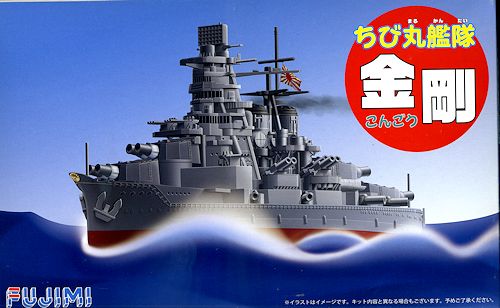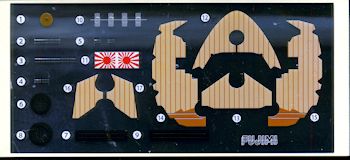
Fujimi IJNS Kongo (Q Ship)
| KIT #: | 421629 |
| PRICE: | $29.95 SRP |
| DECALS: | One option |
| REVIEWER: | Scott Van Aken |
| NOTES: | New tool |

| HISTORY |
Kongō (金剛, "indestructible", named for Mount Kongō) was a warship of the Imperial Japanese Navy during World War I and World War II. She was the first battlecruiser of the Kongō class, among the most heavily armed ships in any navy when built. Her designer was the British naval engineer George Thurston, and she was laid down in 1911 at Barrow-in-Furness in Britain by Vickers Shipbuilding Company. Kongō was the last Japanese capital ship constructed outside Japan. She was formally commissioned in 1913, and patrolled off the Chinese coast during World War I.
Kongō underwent two major reconstructions. Beginning in 1929, the Imperial Japanese Navy rebuilt her as a battleship, strengthening her armor and improving her speed and power capabilities. In 1935, her superstructure was completely rebuilt, her speed was increased, and she was equipped with launch catapults for floatplanes. Now fast enough to accompany Japan's growing carrier fleet, Kongō was reclassified as a fast battleship. During the Second Sino-Japanese War, Kongō operated off the coast of mainland China before being redeployed to the Third Battleship Division in 1941. On the eve of World War II, she sailed as part of the Southern Force in preparation for the Battle of Singapore.
The Kongō fought in a large number of major naval actions of the War in the Pacific during World War II. She covered the Japanese Army's amphibious landings in British Malaya (part of present-day Malaysia) and the Dutch East Indies (now Indonesia) in 1942, before engaging American forces at the Battle of Midway and during the Guadalcanal Campaign. Throughout 1943, Kongō primarily remained at Truk Lagoon in the Caroline Islands, Kure Naval Base (near Hiroshima), Sasebo Naval Base (near Nagasaki), and Lingga Roads, and deployed several times in response to American aircraft carrier air raids on Japanese island bases scattered across the Pacific. The Kongō participated in the Battle of the Philippine Sea and the Battle of Leyte Gulf in 1944 (October 22–23), engaging and sinking American vessels in the latter. The Kongō was torpedoed and sunk by the submarine USS Sealion while transiting the Formosa Strait on 21 November 1944. She was the only Japanese battleship sunk by submarine in the Second World War, and the last battleship sunk by submarine in history.
| THE KIT |
 Some
thirty or more years after Hasegawa introduced egg planes, Fujimi has decided it
was time to do the same sort of thing to ships. In Japan things like this are
often regarded as SD (Super Distorted) kits and is quite common in anime figure
kits where generally the head is huge in proportion to the body. This is one of
three inital 'Q-ship' offerings the other two being the Yamato and Musashi
(naturally).
Some
thirty or more years after Hasegawa introduced egg planes, Fujimi has decided it
was time to do the same sort of thing to ships. In Japan things like this are
often regarded as SD (Super Distorted) kits and is quite common in anime figure
kits where generally the head is huge in proportion to the body. This is one of
three inital 'Q-ship' offerings the other two being the Yamato and Musashi
(naturally).
I have to say that the effect works well with this kit. It is molded in mostly grey plastic with those items below the waterline molded in dark red. The kit can be built as a waterline, though it is intended to be full hull. Like Revell ship kits of the 50s, this one has a flat bottom hull (to make it easier to scoot across carpeted floors, undoubtedly) and there is no display stand, though there are props and rudders.
The attachment points of all the parts are quite large and while I doubt this is actually a snap kit, there should be no issues with getting parts properly aligned or installed. There are three large blacks that fit into the lower hull over which the upper hull and deck section are attached. The superstructure pieces are well done and provide a nicely done representation of those areas found on the real ship. Same goes for the various guns and gun tubs. It appears that the main armament can be posed as one wishes. There are no provisions for aircraft so this must be considered to be representative of the initial overhaul as it still has the casemate guns.
 The kit
provides stickers for things like the wood deck, flags, and other areas of the
ship. I am somewhat surprised by the chrome foil backing on these and would hope
that they stick fairly well once pressed down as they will be used to cover some
relatively convoluted surfaces (such as the funnel caps). Instructions are
entirely in Japanese and painting will be minimal as kits go if one so wishes to
build it as such. Color references are for Gunze paints.
The kit
provides stickers for things like the wood deck, flags, and other areas of the
ship. I am somewhat surprised by the chrome foil backing on these and would hope
that they stick fairly well once pressed down as they will be used to cover some
relatively convoluted surfaces (such as the funnel caps). Instructions are
entirely in Japanese and painting will be minimal as kits go if one so wishes to
build it as such. Color references are for Gunze paints.
| CONCLUSIONS |
I think this is a pretty neat kit. Modelers who want to add a touch of whimsy to their building and have something to construct that is relaxing and a nice change from the norm will find this one worth seeking.
| REFERENCES |
http://en.wikipedia.org/wiki/Japanese_battleship_Kong%C5%8D
February 2014 Thanks to www.dragonmodelsusa.com for the preview kit. You can find
this kit at your favorite hobby shop
or on-line retailer. If you would like your product reviewed fairly and fairly quickly, please
contact
the editor or see other details in the
Note to
Contributors.